These days, PR and SEO are more intrinsically linked than ever. After all, two of the most important SEO ranking factors are both natural outputs of PR: backlinks and content.
However, a lot of companies approach SEO and public relations as two separate activities, run by separate teams or managed by separate agencies. This can massively reduce the effectiveness of both activities, while also increasing costs. Crazy or what?
But the good news is, it’s easier than you might think to create a combined SEO PR strategy. Here at Publicize we manage digital PR and SEO on behalf of many startups and other businesses. So in this guide I’ll be sharing all our industry knowledge, including:
- How to create a combined SEO PR strategy
- Guest blogging for SEO
- How to win media coverage with backlinks
- When and how to syndicate content
- Press releases and SEO
How PR and SEO are intrinsically linked
Before I explain how to combine your digital PR and SEO strategies, I’ll firstly explain how they’re so closely related.
Here’s a super quick summary that’s worth spending 5 minutes reading, before you jump into the “how to” section.
It’s all about the backlinks baby!
It really is! Even in 2020, with the hundreds of ranking factors that Google now applies to organic search rankings, backlinks still remain one of the most fundamental aspects of SEO.
And not only are they still vital, getting the “right type” of backlink has become harder than ever. You have to be reaching for backlinks from high authority sites and sites within your niche.
These backlinks need to be “editorially placed” in that they were placed there because they provide value to the reader. Think of it as earning rather than winning a backlink – you have to work hard to earn something!
So how do you earn backlinks from high authority sites?
Enter stage right: the art of public relations. It’s the job of digital PR to win media coverage in online publications. Hey, we even class this as earned media – are you starting to see the connection between SEO and public relations?
When you win a piece of earned media, the article will usually include a backlink to your site. And these are super valuable backlinks: they’re editorially placed and in high authority or industry niche publication websites.
Content is king
My favourite marketing cliche! You’ve no doubt read this countless times before, but that’s because it’s true. In a post rankbrain world, Google places more emphasis on the quality of content than ever before and has made content marketing and SEO intrinsically intertwined.
Let’s say you only invest in creating a few core pages on your site, such as your homepage and product pages, then earn some high authority backlinks, you could be successful in ranking for a few broad keyword terms.
But if you want to rank for as many keywords as possible, to onboard organic traffic at all stages of the purchase funnel, then you have to invest in content.
Meanwhile, public relations relies on pumping out great quality content in order to win earned media. Once again – do you see where I’m going with this (I’m sure you do)?
You can therefore be way more efficient and get way more value out of combining your PR and SEO content efforts. From research, ideas generation, content writing and promotion. How you do this is explained below.
Digital footprint
Your digital footprint is your online reputation. What a user finds on the first page of Google when they enter your brand name is really important. It’s the first impression you make with the vast majority of people who engage with your brand. So how to create a positive digital footprint?
You want your website to be in the top spot, obviously! Your social profiles should also occupy some of the results. But to really make a good impression, the average user is going to want to see more than a nice website and witty Twitter account saying how awesome you are.
For maximum credibility (especially if you’re a startup), users also need to find mentions of your brand in high authority websites, such as publications or review sites. This kind of positive social proof can propel you from an unknown entity into a credible business.
This is what public relations delivers.
While your digital footprint isn’t quite the same thing as the SEO of your own websites, it’s all linked. The more earned media you win – the more backlinks you win – the more it improves your website’ ranking – the more articles mentioning your brand users can find when searching for you – the more visibility and credibility you have.
Here’s a model example of a perfect Google page one for a startup.
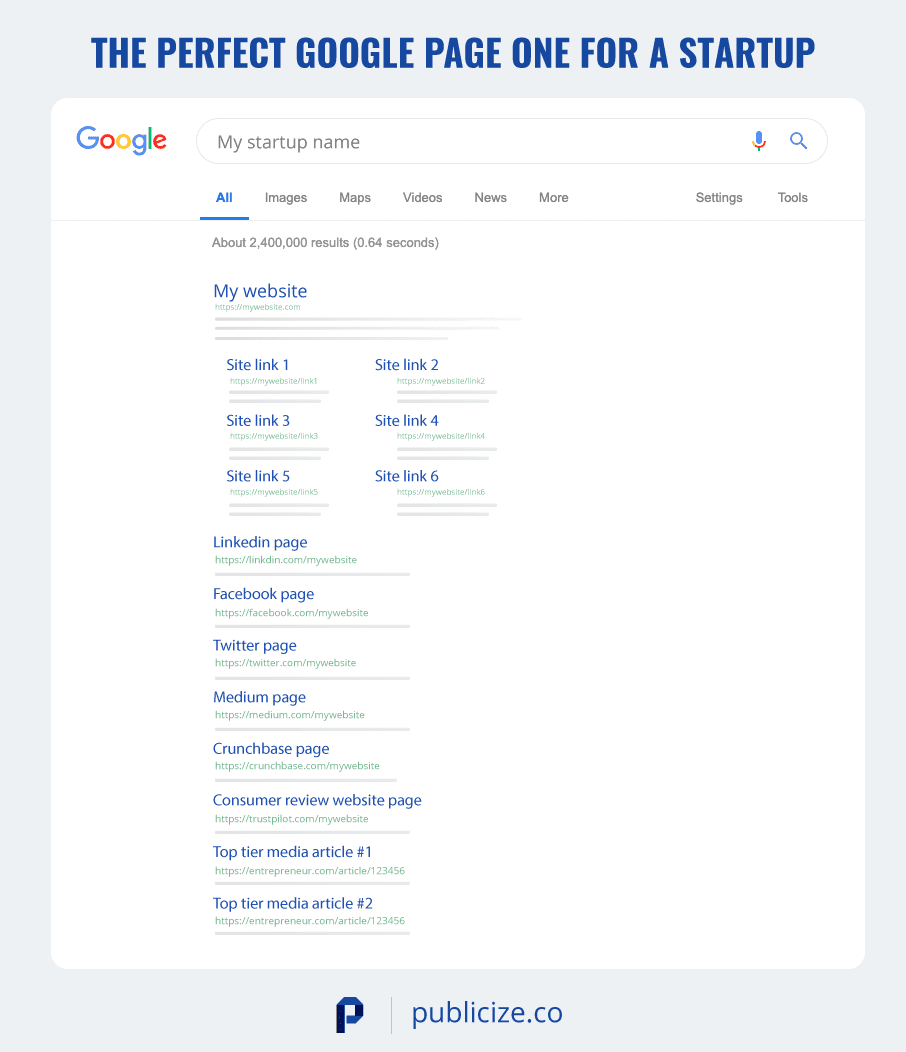
Now you know the theory, time for the practical. In this section I will explain how to combine PR and SEO for best effect.
Align your SEO and PR content strategies
Content strategy may be a grandiose term for many startups and small businesses, but don’t let this deter you. You don’t need to intricately map out 12 months worth of blog posts, articles, guest posts and press releases. However, combining your PR and SEO objectives begins with joining up the dots with your content.
Here’s what a combined PR SEO content strategy looks like:
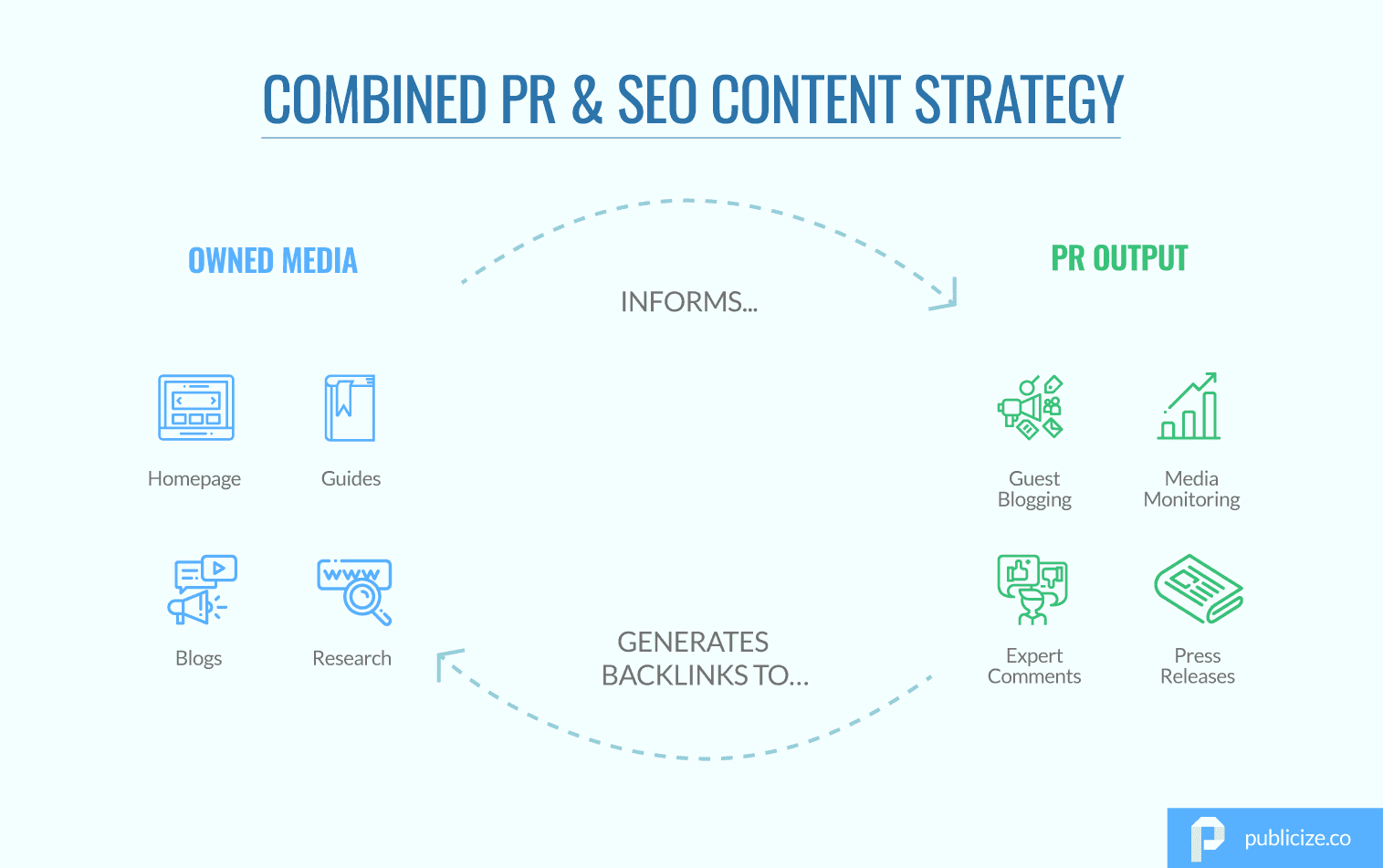
So first thing – what keywords do you want to capture with your website?
Well, here’s a super high level walk through, but for a far more thorough guide to keywords, I highly recommend this Backlinko guide.
Step 1
Think about body keywords that best describe your product or service. These are short descriptive terms.
For example, here at Publicize we specialize in PR for startups, so some of our body keyword terms are “PR companies for startups”, “PR for startups” and “PR agency for startups”.
Step 2
Use a keyword explorer tool such as SEMrush or Moz (both of them offer 1 month free trials, which is plenty of time for your research). You’ll be able to explore all related keywords, and see the monthly search volume and difficulty score of each. You want to aim for keywords in that sweet spot of good monthly volume but lower difficulty.
Step 3
Now you’re clutching a fistful of valuable target keyword phrases, you need to think about the type of content you need to create to capture these searches. This part is really easy. Just Google each keyword phrase and look at the content that’s ranking on page one.
Step 4
This research not only informs the type of content you need to create on your website, to capture your target keywords, it also informs your PR strategy, enabling you to:
- Plan guest blogs on subjects related to owned media content. This enables you to place contextual backlinks into your guest blog articles back to your supporting owned media content.
- Plan “impactful” content campaigns, such as original research or data studies, which are published on your site. These are then amplified with PR, such as via press releases. Journalists can then write these up into articles, which will usually contain backlinks to the original content you’ve published on your site.
- Know which keywords to use when writing press releases, and when providing quotes, insights and opinions to journalists.
- Know which keywords you should set up a media monitoring for, to track and respond to any news stories in order to win media coverage.
Guest blogging for SEO
Guest blogging is one of the best tools to use in a PR SEO strategy. It’s the ultimate two birds with one stone. You get to build your exposure and credibility with your target market by increasing your digital footprint, while also earning backlinks from high authority websites.
And here’s how you can earn those valuable backlinks from guest blogging.
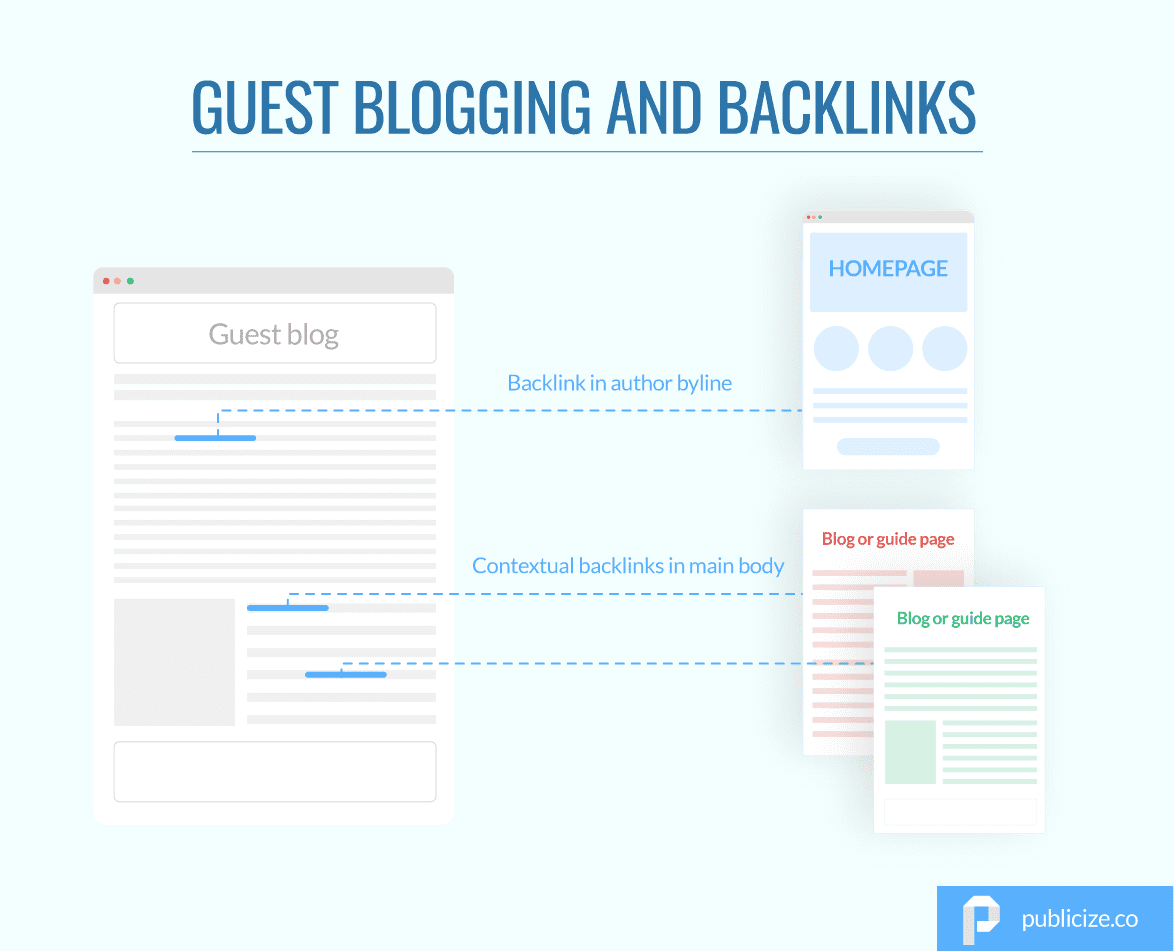
But before I explain how to guest blog for SEO, I’ll preface this section with a quote from Matt Cutts, Google’s then Head of Web Spam.
“So stick a fork in it: guest blogging is done; it’s just gotten too spammy…I wouldn’t recommend relying on guest posting, guest blogging sites, or guest blogging SEO as a link building strategy.”
Matt Cutts – Head of Web Spam, Google, 2014
As you can see, that was back in 2014. So has the PR and SEO industry stopped guest blogging?
Not at all!
What has changed is that quality is now fundamental, both in terms of the guest blogs you write and the websites they’re published on. In the past, lazy SEO agencies would spin half a dozen articles from the same base article, then get them published on a bunch of spammy, low authority sites. It’s this approach that no longer works.
So here are the guest blogging for SEO best practices in 2020:
- Don’t guest post just for the sake of earning backlinks. View this as a byproduct of guest posting. The primary purpose of guest posting, from a PR perspective, is to establish yourself as a thought-leader. So approach every guest blog you write in terms of how you can demonstrate this, such as the valuable insights you can provide to the reader.
- Each guest post you write has to be original. Do not rewrite variations of the same article to get it published on multiple sites, or submit content that’s already on your site. This is called content spinning and can result in a Google penalty.
- Avoid low authority spammy looking sites like the plague! You want to aim for top tier sites first, then mid tier sites. As a rule of thumb, top tier sites in your niche should have a DA of at least 65, while medium tier sites should have a DA of 50 to 65.
Now you know what not to do with guest blogging and how to approach it with the correct mindset, here are the more specific SEO factors to bear in mind:
- There are two places you can get backlinks when guest blogging: the author byline/bio and within the body of the actual article.
- Make sure the websites you’re pitching to feature author bios for guest posts, which include a backlink to the author’s website. However, bear in mind…
- There are two types of backlinks: follow and nofollow. A nofollow backlink passes no value to the website it’s linking to. Therefore, when it comes to guest blogging for SEO, you only want to guest post on websites that offer follow backlinks. Here’s how to check if a backlink is follow or nofollow.
- Check whether the author byline backlink AND the backlinks within the body of the article are follow or nofollow. Sometimes, both are follow, sometimes the author byline backlink is follow, but backlinks in the main body are nofollow, or vice versa.
- Your ideal target will be a high authority website in your niche that has follow backlinks on the author’s byline and within the body of the article.
- The consensus of opinion within the SEO industry when it comes to guest blogging is that contextual backlinks (those within the main body of the article) are more valuable than backlinks within the author byline. So consider this when checking follow and nofollow backlinks.
- When it comes to inserting contextual backlinks to your own site, they have to be editorially relevant (i.e. the content it links to offers further reading on a subject), the anchor text shouldn’t be stuffed full of keywords, and only put one or two in per article.
Winning media coverage with backlinks
Here’s one of the best ways to win media coverage, which is a staple of all PR output.
If there’s breaking news in your industry, such as a huge merger, a major piece of new legislation, or even a big scandal, journalists will be all over it. But journalists don’t want to report the same news as everyone else. They’re always on the lookout for a unique angle or original source.
You can provide journalists with a unique angle, by offering to provide an expert comment or opinion. After all, you know your own industry better than most.
And when a journalist uses you as a source in an article, you’ve guessed it, you’ll usually get a backlink. So it’s another great PR SEO win-win. Not bad for a 10 minute email or phone call!
Here’s a typical example of an expert comment we win on behalf of our clients.
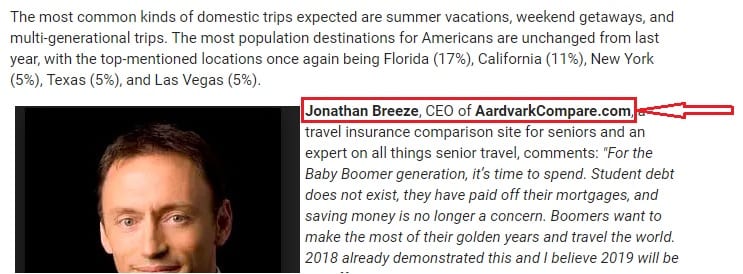
In terms of how to do this, there are two ways you can go about it:
Option 1: The proactive approach – jumping on the news when it happens
Step 1
This requires you to have media monitoring in place, to keep track of what’s going on in your industry. Read our guide to media monitoring to find out how to set this up and the best free tools to use to do this.
Step 2
Once your media monitoring is in place, you also need to have a list of the main journalists that report on your industry. Our guide to finding journalists and their contact details talks you through how to do this.
Step 3
Your media monitoring will then alert you to any breaking news within your industry. Whenever there is a big piece of news that you feel you can provide expert comment or opinion on, you just need to reach out to your list of journalists.
Option 2: The reactive approach – responding to journalists requests
The other option is to sign up for platforms where journalists are looking for expert sources. The market leader in the PR world is HARO (Help a Reporter Out). It’s free to use and super easy. Once you sign up you’re sent three emails a day with a complete list of all the stories that journalists are requesting sources for.
Here’s an example of a typical request you receive via HARO:
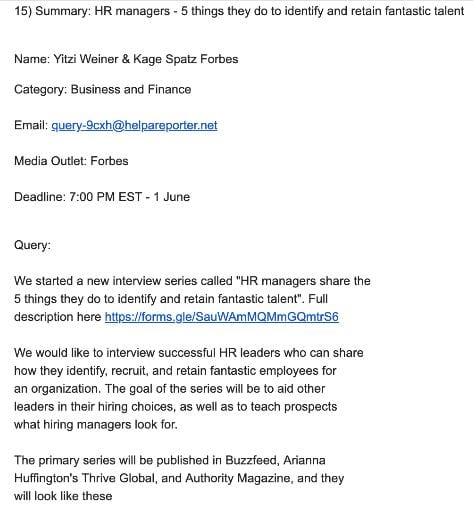
You can then respond to any requests that match your expertise. But be warned, the average request gets a lot of responses from would be sources. So just focus on requests where you can clearly demonstrate your expertise and suitability.
SourceBottle is another platform that’s free to use. While it’s smaller than HARO, it comes with the benefit of being able to filter the requests you receive by industry. Sign up to both and double your chances of winning earned media with backlinks.
How and when to use press releases for SEO
A lot of people can get confused when it comes to the subject of press releases and SEO. You can get an SEO benefit from press releases, but it’s the message, not the medium, that’s crucial.
When a press release won’t provide any SEO benefit
A press release by itself won’t give you any SEO benefit. Here’s why.
One of the ways you can send out a press release is to put it onto a press release distribution service (called a wire service in the PR biz). Anyone can upload any press release to these platforms – some you need to pay for, while others are free.
In the past, you could upload press releases to these services with follow backlinks inserted in the text. This inevitably resulted in the wide scale misuse of these wire services. People would just write press releases about anything, such as to announce some new carpet that was laid in their office, just to get backlinks.
So both Google and most wire services put a stop to this. Reputable wire services set all backlinks to nofollow by default. Meanwhile, Google doesn’t place much value in backlinks from these sites.
When to use press releases for SEO benefit
A press release is just a medium to transmit a message. It’s the message that’s the important thing. If you’re announcing something that’s actually newsworthy, then there’s a good chance a journalist will write up your press release into an article. And when it becomes an article authored by a journalist, that article will most probably contain a valuable backlink.
Some of the most effective announcements communicated via press releases, that generate media coverage include:
- A company update that has significance to your industry – If you’re announcing an update that will be of interest to your industry, then there’s a good chance the industry press will pick this up. Read our guide to press releases for more information on how to determine a newsworthy announcement.
- Original research – Any research that sheds new light on a topic, challenges conventional wisdom or captures the zeitgeist has a good chance of getting picked up by journalists when sent out in a well-written press release. Publish the full findings on your website and include plenty of infographics to encourage backlinks in articles.
- Data analysis – If you’re a business that processes plenty of data, form interesting narratives and insights from this, publish the findings on your site, then send out a press release with full details of your study and findings.
Example of a press release and SEO working together
Seniorcare.com commissioned a study into ageing in the US and published its findings on its website.
We then wrote up the findings in a press release and sent this to relevant media outlets.

The page on their website with the published findings has now received 132 backlinks, following all the articles that were written about the study’s findings.

Of course, the purpose of commissioning this study wasn’t to win backlinks, it was to advance the organization’s aims and objectives. But this is a great example of PR and SEO working together, to help further those objectives.
Leverage your content for SEO and PR
By this, I don’t mean the outdated practice of content spinning, where you slightly rewrite an article half a dozen times. As I mentioned above, this is very outdated SEO which could result in a nasty Google penalty.
Instead, you want to get the maximum amount of value out of every piece of earned media you win.
Syndicate guest blogs on your own site
A great way of maximizing the SEO value of content you’ve written is syndicating guest posts you’ve authored onto your own site.
This is where you republish a complete copy-and-paste of a guest blog you’ve written, on your own site, such as in a blog post. Some people are wary about doing this, due to issues around duplicate content, but as long as you follow these guidelines, you’ll be fine:
- Check that the website which published your guest post is okay with syndicated content
- Place a rel=canonical tag on the page, which points to the original article. This tells Google that this is a copy of the original version and avoids problems with duplicate content
- Clearly state on the page that this is a syndicated copy and state where the article originally appeared
Here’s what a syndicated article should look like on the page:
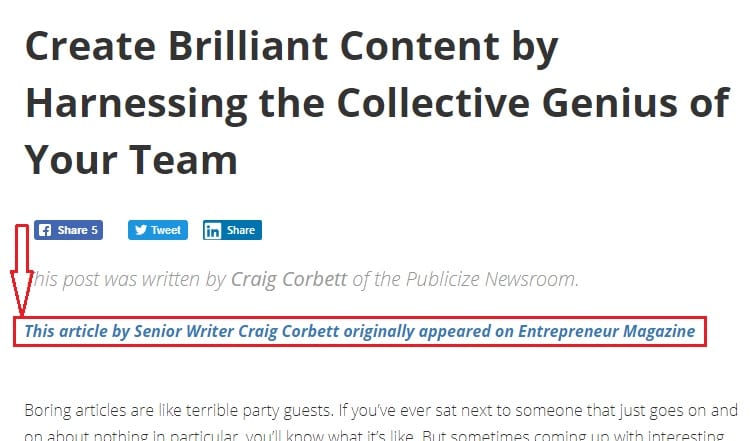
Syndicating this content will provide a number of indirect SEO benefits:
- Having lots of engaging and long-form content across your website will increase average session times and average pages per session. These are both important user signals that Google uses to determine the relevance of a website when returning search results.
- Having lots of content that provides an in-depth discussion on a certain topic improves sitewide relevance, which helps rankings for target keywords over the long term.
Publish rejected guest articles on your own site
Every now and again a website may accept your guest post pitch, but will then reject it when you send the final draft. This is obviously very disappointing. But look at it this way, you’ve written a great piece of long-form content, so put it up on your website as a blog post, where it can capture search and gain backlinks.
Boast about all your great media coverage
The “as featured in” bar is the envy of every day-one startup. If you’ve won media coverage in top tier and respected publications in your industry, boast about it on your homepage and all other landing pages into your site.
This acts as an important trust signal to users, which can lower your website’s bounce rate and increase your conversion. Lower bounce rate and average session duration are important user signals, which are now fundamental to SEO.
Here’s an example of this on our website.
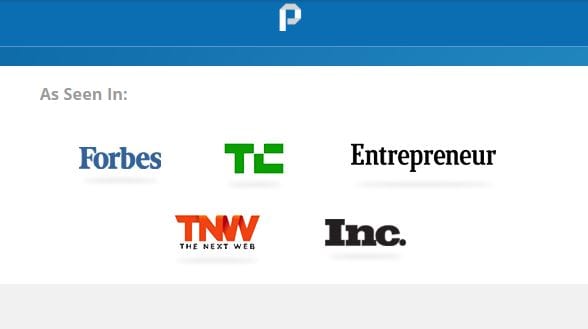
Turning organic mentions into backlinks
As your business grows and your brand becomes more widely known, you’ll start picking up organic media mentions. This is where journalists or bloggers mention your brand without you having to do any PR activity.
Here’s an example of a typical organic media mention of our brand.

A fundamental activity of PR is monitoring all media mentions that a brand receives, to track brand sentiments (or in plain English: keep on top of what people are saying about you). But when it comes to PR for SEO you want to track all these mentions to ensure you gain as many backlinks as possible.
When you gain organic media mentions, it’s kind of pure luck whether or not the journalist or blogger will think to insert a backlink to your site in the article.
If they do – that’s great, you’ve earned a backlink without having to lift a finger. That’s the SEO equivalent of finding a $20 dollar bill when you’re walking down the street.
If they don’t, send them a polite message asking if they can insert a backlink using your brand name as the anchor text. If an article mentions your company, it’s editorially relevant and beneficial to user experience to provide a link.
Journalists and bloggers are usually happy to do this if you ask. But obviously be polite, and don’t keep them chasing them if you get no reply.
Read our guide to media monitoring to find out how to set up effective monitoring of your brand mentions. And here’s our guide to finding journalists’ contact details, so you know who to contact.
Final thoughts
As you can see, SEO and public relations have plenty of overlap. The two key elements at play here are content and backlinks. Aligning your PR and SEO content strategies will enable you to plan and execute your own media content, which you can then overlay with PR activity to win backlinks.
And as this guide shows, there are also plenty of other public relations techniques you can take advantage of, to benefit your SEO strategy.
So for maximum effect, create a combined PR SEO strategy, to both increase your visibility and credibility with your target market, and to improve your website’s organic search rankings.





